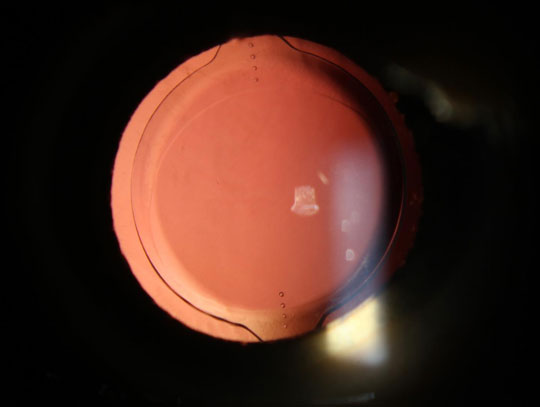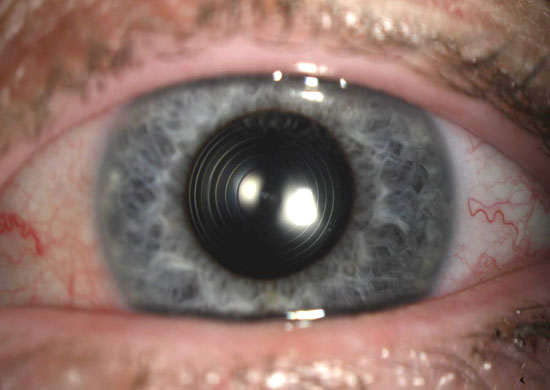BLOG: How to comanage patients receiving toric IOLs
With modern cataract surgery allowing for the correction of refractive error, including astigmatism and presbyopia, the refractive demands placed on this procedure are higher than ever.
As optometrists in a large comanagement practice, we have the unique privilege of doing all of the IOL calculations and a lot of the high-level surgical planning for our patients.
inder), reducing astigmatism (when preoperative lenticular cylinder is additive to corneal cylinder) or increasing astigmatism (when lenticular cylinder was subtractive to corneal cylinder).
Because of this, preoperative refraction plays a small role in establishing candidacy for toric IOLs. Instead, determining candidacy has to do with measuring keratometric values, as these will be the only remaining influence on postoperative astigmatism.
At our clinic, we compare Scheimpflug imaging, traditional automated optical keratometry and, occasionally, manual keratometry to give a best assessment of both magnitude of astigmatism and its axis of orientation. Even trusting multiple K values, however, simplifies things to some degree, as we know that posterior corneal astigmatism, which is not measured with traditional keratometric devices, will add a small amount (usually 0.25 D to 0.5 D) of against-the-rule astigmatism. Therefore, total postoperative astigmatism can generally be expected to have slightly more against-the-rule cylinder then what is suggested by Ks.
Prior to toric IOLs, patients who had a visually significant amount of corneal astigmatism were dependent upon updating their eyeglass prescription or corneal surgery after cataract surgery to achieve their best visual acuity. For the approximate 35% of patients who have more than 1.00 D of corneal astigmatism, they will have a decision when it comes to which IOL they would like to have implanted. A toric IOL is considered a “premium” IOL, which translates to an out-of-pocket expense, so this is generally an IOL for patients who are refractively motivated to be free from their spectacles for distance vision. Although modern toric IOLs have a power range of up to 6 D, this translates into about 4.5 D of astigmatism at the corneal plane, meaning any eye with greater than 4.5 D of corneal cylinder will still have some postoperative astigmatism.
We have found the risk-to-benefit ratio of a toric IOL to be very good. There are very few risk factors associated with a toric IOL when compared to a spherical IOL. During surgery, if the capsule tears, there is a chance the surgeon will not be able to place the toric lens, which the patient should be made aware of, although this is uncommon. The primary concern worth counseling patients on is the possibility of a rotation, which occurs in 3% to 5% of toric IOLs. Similar to the rotation of a toric contact lens, this renders the optics to be off with the induction of residual astigmatism through a cross-cylinder effect. As expected, higher-powered toric IOLs have less room for error before the patient begins to be affected. For every degree rotated, there is a decline of toric efficacy of about 3.3%. This can be visually significant even with 10 degrees of rotation.
When a toric IOL rotates, it generally will do so fairly soon in the postop period. This is due to capsular redundancy – remember, the natural lens is much thicker than the IOL, and so, initially, the capsule will be oversized, leading to the potential for the IOL to rotate. Within 1 to 2 weeks’ time, the capsule has contracted around the IOL more tightly and prevents rotation. As with toric soft contact lenses, there are reference marks on toric IOLs indicating their orientation. Unlike toric soft contact lenses, where the position of these marks is uniform for all patients (within a certain brand of contact), toric IOL marks will be oriented differently from patient to patient.
To assess the orientation of the IOL, the comanaging OD needs the surgery center to provide the intended axis and to compare the end position of the marks on dilated exam with their intended location. Findings that can clue you in to a rotated toric IOL will be decreased unaided visual acuity and residual astigmatism on refraction.
If misalignment of a toric IOL is visually significant, the most common treatment is to take the patient back to the operating room for a toric reposition. It is also important to note that the predicted IOL position preoperatively may not be found to be the best postoperative location. When planning for a postoperative toric rotation, we always run the numbers through an online cross cylinder calculator to ensure we really are going to improve refraction with the rotation.
Now that we have laid the foundation for toric IOLs, let’s venture down the path of another option that goes one step further. The Tecnis Symfony IOL (Johnson & Johnson, formerly Abbott Medical Optics) hit the market in the summer of 2016. It was the first IOL to be considered extended depth of focus (EDOF). This concept is similar to a multifocal IOL in that its goal is to mitigate presbyopia but it has addressed some of the problematic points of multifocal IOLs of the past. The EDOF optics elongate the focus rather than splitting the light into two distinct focal points. This results in better intermediate vision and reduces the incidence of glare, although haloing in scotopic settings with both multifocal IOLs and EDOF IOLs is still encountered.

Proper patient selection and intense counseling with premium IOLs is paramount. It is both a subjective and objective task — identifying clinical pathology and assessing personality and lifestyle. When it comes to screening for patients who would be good candidates for a multifocal or EDOF IOL, it is important to rule out corneal or retinal pathology that may hinder the performance of the IOL. We often do a dry eye work-up and macular OCT to screen each candidate. Subtleties on corneal topography as well as staining will help pick up dry eye.
It should be noted that EDOF IOLs generally have a better intermediate point of acuity than near point with an emmetropic outcome. To account for this, we will often do preoperative dominancy testing in the clinic as well. Surgery on the dominant eye first will allow for adjustments on the second IOL if the near vision is not adequate. We have targeted a low minus (-0.50 D to -0.75 D) on the second eye to allow good distance vision binocularly but also optimize near vision.

Refractively, most preoperative hyperopes seem very happy with this IOL. Low to moderate myopes need a special set of counseling on the near vision, as it may not be a lateral move from their unaided visual acuity. Higher myopes do fairly well but may need to realize that their new focal point will be extended out beyond their habitual uncorrected working distance.
In day-to-day practice, we find that there is definitely a period of neuro-adaptation with the EDOF IOL. The patient should be counseled that their vision will seem less-than-desirable in the early postoperative period, which will set them up for realistic expectations.
Several factors play into this: residual mydriasis from surgery, inflammation, new dysphotopsia and the need for neuro-adaptation. We’ve found this piece of the counseling to be especially important so that patients are not worried right after surgery and understand the importance of patience as the eye heals and the brain adapts to the new optics. Vision seems to improve significantly by the 1-week postop appointment and improves steadily at 1 month and beyond. Despite EDOF IOL improvement in some of the historic visual quality issues associated with multifocal IOL technology, there are occasional patients who will be persistently bothered by these phenomena and require an exchange to a conventional IOL.
While toric IOLs and even multifocal/EDOF IOLs cannot eliminate the need for glasses for all tasks, they can be very useful in lessening the need for glasses much of the time. With proper patient selection and patient education, we have seen excellent visual satisfaction in the majority of patients who opt for these technologies.
